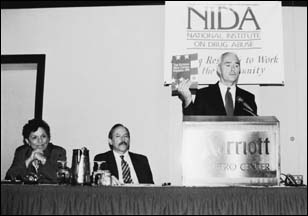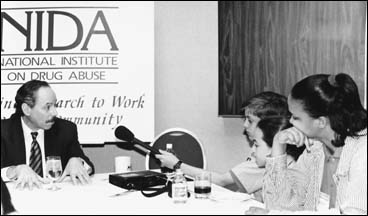With antidrug attitudes eroding and drug use increasing among the Nation's youth in recent years, NIDA held the National Conference on Drug Abuse Prevention Research: Putting Research to Work for the Community to transfer effective drug abuse prevention approaches from research settings to communities. More than 400 community leaders, representatives of national organizations,and drug abuse prevention researchers and practitioners met in Washington,D.C., last September to attend the conference, which was cosponsored by The Robert Wood Johnson Foundation.
 Keynote speakers at NIDA's national prevention conference were, from left, Dr. Donna E. Shalala, Secretary of Health and Human Services; NIDA Director Dr. Alan I. Leshner; and General Barry McCaffrey, Director of the White House Office of National Drug Control Policy. Their message to conference participants: scientific research has shown that drug abuse prevention works.
Keynote speakers at NIDA's national prevention conference were, from left, Dr. Donna E. Shalala, Secretary of Health and Human Services; NIDA Director Dr. Alan I. Leshner; and General Barry McCaffrey, Director of the White House Office of National Drug Control Policy. Their message to conference participants: scientific research has shown that drug abuse prevention works.The overriding message keynote speakers Dr. Donna E. Shalala, secretary of Health and Human Services; General Barry McCaffrey, director of the White House Office of National Drug Control Policy; and NIDA Director Dr. Alan I. Leshner delivered to conference participants was that scientific research has shown that drug abuse prevention works. "More than 20 years of NIDA-funded research have given us powerful tools and guidance about how to prevent drug use," Dr. Leshner said. "Now we need to work with the community to put those tools to use," he stressed.
"Families, schools, and communities have a clear charge to take up these tools and help build drug-free environments," Dr. Shalala said. To help accomplish this, Dr. Shalala announced a new partnership between NIDA and Scholastic, Inc., a publisher of educational magazines and materials. As a result of the joint effort, a number of prevention materials containing the latest science-based information about commonly abused drugs have reached 2.3 million of the Nation's third- through sixth-grade students and their families. (See "Initiative Brings Lessons To Fight Drug Abuse Into Nation's Schools and Homes,")
Research presented at the 2-day conference indicates that the best drug abuse prevention results are achieved when comprehensive interventions built on scientific findings about the many factors involved in the initiation of drug use are implemented. Rigorous evaluations have shown that well-designed interventions that focus on influencing these factors in the family, the school, and the community can reduce drug use substantially among adolescents. Following are some of the key prevention findings highlighted at the conference.
- In separate presentations, Dr. Robert Pandina of Rutgers University in Piscataway, New Jersey, and Dr. William B. Hansen of Tanglewood Research in Clemmons, North Carolina, noted that research has identified a large number of biological, behavioral, family, and environmental factors that either increase or reduce the likelihood of drug use. Prevention programs need to assess and target these risk and protective factors in the individual, the family, the school, peer relationships, and the environment, while remaining flexible enough to respond to changes in these factors across the life span, Dr. Pandina said. Prevention programs that are based on changing these variables can result in significant reductions in drug use, Dr. Hansen said. Programs "based on scientific data are most likely to suceed," he said.
- Dr. Thomas Dishion of the Oregon Social Learning Center in Eugene said that families constitute one of the earliest and most important domains of drug abuse risk and protective factors. "We need to integrate families as early as possible in prevention programs," he said. "Parental monitoring" should be at the core of family intervention programs, Dr. Dishion stressed. Parental monitoring basically means that parents oversee what is going on in their children's lives, how they are doing in school, and who their friends are. Dr. Dishion's research shows that programs that help parents become more effective in setting limits, solving problems, and providing positive reinforcement for their children reduce early behavioral problems, adolescent delinquency, and substance abuse.
- Dr. Gilbert Botvin of Cornell University in New York City said that comprehensive life skills programs that teach self-management along with social and drug-resistance skills in middle and junior high school offer the most promise for school-based prevention programs. Evaluations of a life skills training program developed by Dr. Botvin show that students who received the initial intervention in middle school and subsequent booster sessions in succeeding grades had dramatic reductions in tobacco, alcohol, marijuana, and multiple drug use throughout the high-risk junior and senior high school years. (For more information on this program, see "School-Based Drug Abuse Prevention Program Shows Long-Lasting Results," NIDA NOTES, November/December 1994.)
- Dr. Mary Ann Pentz of the University of Southern California in Los Angeles stated that the best drug abuse prevention results are achieved when parents, schools, the mass media, and community organizations work together to foster the personal, social, environmental, and policy changes that result in reduced drug use. Long-term prevention research studies that Dr. Pentz has conducted in Kansas City and Indianapolis show that coordinated, multicomponent community-based programs can reduce adolescents' use of cigarettes, alcohol, marijuana, and cocaine, she said.
 At a special press conference held during the prevention conference, NIDA Director Dr. Alan I. Leshner takes questions from reporters from Washington, D.C., area high school newspapers and from the cable television show, "Children's Express," shown here.
At a special press conference held during the prevention conference, NIDA Director Dr. Alan I. Leshner takes questions from reporters from Washington, D.C., area high school newspapers and from the cable television show, "Children's Express," shown here.After their presentations, the scientists met in work group sessions with State and community representatives and other conference participants to discuss the practical aspects of applying their research findings in the community. The conference concluded with the scientists presenting summary reports of their work group discussions, including recommendations for expanded dissemination of prevention research and potential areas for new research.
NIDA will publish a report on the National Conference on Drug Abuse Prevention Research that will include keynote speeches, comprehensive summaries of the scientific presentations, work group reports, and recommendations. NIDA Notes will notify readers when the report is available.
The Institute has published a new research-based guide on preventing drug use among young people that is now available for distribution. For information about the guide and how to obtain it, see "NIDA Designs Research Guide to Aid Community Prevention Efforts."
